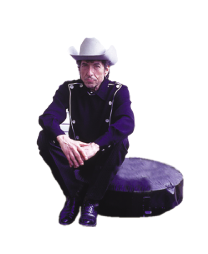A protean physical phenomenon and never less than a spectacular camera subject, Bob Dylan has met with uneven success in movies. Given his imagistic radiance and gifts of storytelling compression, he would seem the most naturally cinematic of artists. (Compare the dramatic punch of Dylan’s “Hurricane” to Denzel Washington’s.) And clearly he has some ambitions in this direction, participating, in various capacities, in at least nine films. Yet outside of the documentaries, onscreen Dylan is all odd angles.1
In scripted roles like those in Hearts of Fire2 (1990) and Masked and Anonymous3 (2003), he perversely offers himself as an object of contemplation only to play the Sphinx.4 He does nothing to ingratiate himself, yet you can’t stop looking at him: not since Buster Keaton have we been treated to so great a stone face. This powerful anticharisma becomes something of a running gag in Masked and Anonymous:5 his impassivity becomes a scrim onto which the other characters—and the audience—project their dreams and desires.
Dylan’s burden as a film performer is the baggage he brings to every appearance—coupled with his nonactor’s inability to transform that audience rapport into something other than “Dylan.” In Pat Garrett and Billy the Kid (1973), Sam Peckinpah’s laid-back, elegiac manhunt movie, the director finds a halfway successful measure for transposing the musician’s presence into a suitably mythic framework. Dylan provided the soundtrack6—painted in jingle-jangle John Wesley Harding colors—and also costars as Alias, a mysterious member of Billy’s gang who’s good with a knife. He looks great in granny glasses, and his singsong, anachronistic delivery wouldn’t be out of place on Deadwood. That, and it’s the only film in which Dylan lassos a turkey while on horseback.
Looking like a hippie rabbinical student, Dylan enters the party late in Martin Scorsese’s The Last Waltz (1978), putting in a generous, good-natured appearance. Fully alert to the other members of the frame, Dylan relaxes as part of an ensemble; watching him communicate a song transition with the Band is thrilling. The Last Waltz also features the best piece of comic timing in Dylan’s movie career: a shrug following the first verse of “Forever Young.”
Flip sides of the same cinéma vérité coin, D. A. Pennebaker’s Don’t Look Back (1967) and Eat the Document (1972) chronicle Dylan’s mid-’60s England tours. The first film is better known for Dylan’s withering sparring sessions with the press than for its superb acoustic performances, while Eat introduces us to the Electric Dylan of the Polka-Dot Shirt. The physical transformation is as dramatic as the musical one: just a year separates the baby fat–cheeked youth from the blade-thin mod king.
“[Dylan] has given himself more tight close-ups than any actor can have had in the whole history of movies,” wrote Pauline Kael of the nearly four-hour documentary-cum-Cassavetes smash-up Renaldo and Clara (1978). Yet what close-ups! If the movie is a wash—with the hipster put-down artist of Don’t Look Back replaced by an inexplicably humorless figure—it’s redeemed by the concert footage. This is the Dylan of Desire: the Jewish cowboy trailing flowers, feathers, and plumes, the shaman in Kabuki whiteface. Dylan performs “Isis” with stunning punk intensity, and “Tangled Up in Blue” peering out from under a floppy-brimmed hat, as if hiding from that song’s emotional implications.
Continually circling back to the Rosetta stone of Dylanology—the mid-sixties electric shows in England—Scorsese’s No Direction Home (2005) is essentially Nabokovian insofar as it doesn’t believe in the chronological reality of time. The definitive self-creation myth, it’s a dialogic work: the old man conversing with the hungry young boy across the decades.
The film’s first edit moves from a tight shot of Dylan in ravaged late-middle-age to the young harlequin keening Like a Rolling Stone before a booing London audience, offering as shocking a statement about the passage of time as the bone-to-spaceship jump-cut in 2001: A Space Odyssey. (Bathed in psychedelic stage lighting, a little prince crowned with a corona of curls, the archival Dylan has something of the star child about him.)
A self-professed “musical expeditionary,” Dylan has always looked to the future by embracing the past. Rather than condemn the counterculture hero for shilling lingerie and MP3 players, let’s give him the benefit of the doubt about that recent iPod spot. At once classic and modern, this filmic footnote takes the familiar monochromatic look of the Apple commercials and nimbly applies it to Dylan: returning him to black-and-white, a solitary figure alone on a stool.





